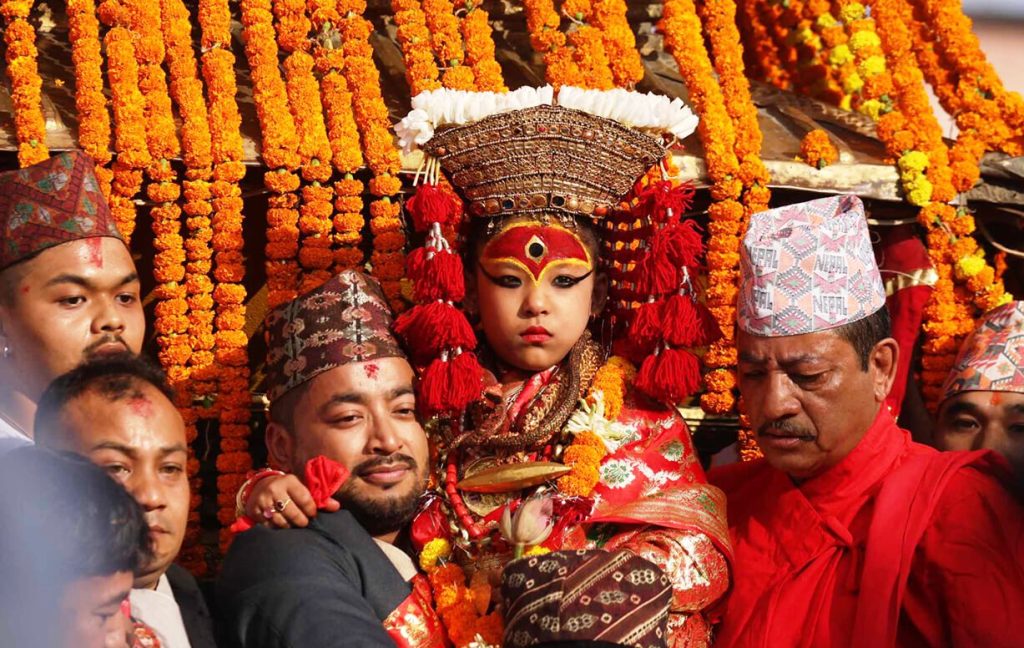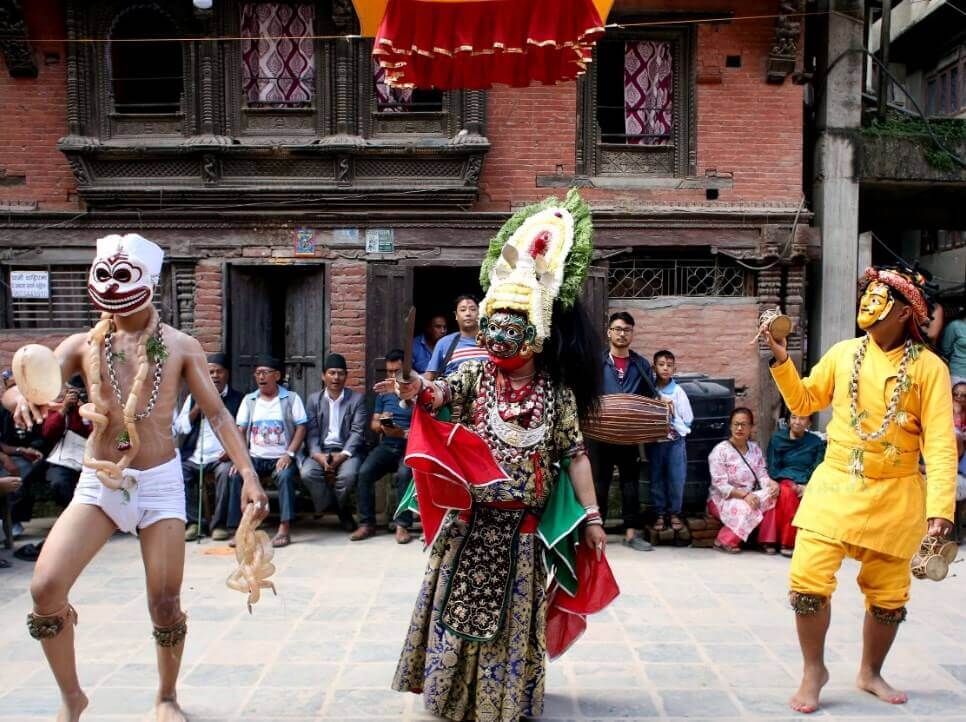The Indra Jatra festival, one of the most significant and colorful events in Kathmandu, Nepal, is celebrated with grandeur and fervor, reflecting the deep-rooted cultural heritage of the Newar community. This eight-day festival marks the end of the monsoon season and the beginning of the harvest period, a time when people come together to honor the god Indra, the deity of rain, and to express gratitude for a bountiful harvest. The festival also celebrates Bhairab, an important deity in Newar culture, believed to be the fierce manifestation of Lord Shiva. The origins of this festival are steeped in mythology, and its celebrations are marked by rituals, dances, and processions that captivate both devotees and tourists alike.
Historical Background of Indra Jatra
Indra Jatra, also known as Yenya in the local Newari language, has its roots in the reign of King Gunakamadeva in the 10th century. It is believed that the festival was initiated to honor Indra, the god of rain, and to ensure a good harvest for the year. According to mythology, the young Indra descended to the Kathmandu Valley in search of parijat flowers for his mother. Upon being caught stealing the flowers by the locals, he was bound and held captive. When his mother descended to search for him, the people realized his divine identity and released him. To make amends, the locals agreed to honor him with a grand festival, and thus, Indra Jatra was born.
In another tale, the festival is associated with Bhairab, a powerful manifestation of Lord Shiva. The Newar community holds that Indra and Bhairab are two aspects of the same divine force, which is why images of both deities are displayed during the festival. The celebration serves as a way to express gratitude to Indra for the rains and to Bhairab for his protection.
The Preparation for Indra Jatra
Preparations for Indra Jatra begin well in advance at least 5 days ahead, involving a series of rituals, cleaning, and decoration of temples and shrines, as well as the arrangement of cultural performances. One of the most important tasks is the raising of the lingo, a ceremonial wooden pole, at Basantapur Durbar Square. This pole, symbolizing the victory of the gods over the demons, is erected with much fanfare and marks the official beginning of the festival.
The raising of the lingo is a sacred event, with a procession of devotees carrying the pole to its location while traditional music and dances accompany them. The pole is believed to represent the cosmic axis, connecting the heavens, earth, and underworld, and its erection is considered to invite the gods to descend and join in the celebrations.
As the festival approaches, the facial images of Bhairab and Indra are cleaned and prepared for display. Hundreds of devotees flock to Basantapur and Indrachowk to catch a glimpse of these sacred images. The Swet Bhairab (White Bhairab) is particularly significant, as its massive facial image remains hidden for most of the year and is only revealed during Indra Jatra. The statue, located behind the Degu Taleju temple, is kept under a wooden curtain and is worshipped daily by a Buddhist priest, known as the Gurju. During the festival, traditional rituals are performed, including the sacrifice of animals such as goats, oxen, and ducks, which are offered to appease the deity.
One of the highlights of the preparations is the brewing of traditional beer (jaand) and the preparation of samaya-baji, a sacred offering made up of five traditional food items. These offerings are distributed to the devotees as prasad, with people eagerly competing to get a few drops of jaand from the mouth of the Swet Bhairab. This ritual is deeply symbolic, with the prasad representing the blessings of the gods.
The Celebrations of Indra Jatra

The festivities of Indra Jatra are vibrant and multifaceted, involving various processions, dances, and rituals that reflect the rich cultural tapestry of the Kathmandu Valley. The festival begins with the hoisting of the lingo and the display of the images of Bhairab and Indra at key locations in the Durbar Square area.
One of the most anticipated events is the Kumari Jatra, which takes place on the third and fourth days of the festival. During this procession, the living goddess Kumari, a young girl believed to be the embodiment of the goddess Taleju, is carried through the streets in a chariot. The chariot is accompanied by processions of deities and masked dancers, creating a mesmerizing spectacle. The Kumari is revered as a symbol of purity and protection, and her blessing is considered to bring good fortune to the people.
In addition to the Kumari Jatra, there are also performances of traditional dances, such as the Lakhe dance, which features masked dancers representing the demon Lakhe, who is said to protect the city from evil spirits. The Lakhe dancers move energetically through the streets, their elaborate costumes and fierce expressions captivating the audience. Other dance performances include the Pulukisi dance, in which a dancer dressed as an elephant parades through the streets, and the Mahakali dance, which involves dancers in elaborate costumes representing the goddess Kali.
The display of the Swet Bhairab is one of the central aspects of the festival. Devotees gather in large numbers at Basantapur to view the massive face of the deity and receive prasad in the form of jaand. The image of the Swet Bhairab is said to have been commissioned during the reign of King Rana Bahadur Shah, and its appearance is considered a symbol of divine protection. The image remains on display throughout the festival, with traditional musical performances, including the playing of dhime (drums) and jogi (flutes), adding to the festive atmosphere.
Another important aspect of the festival is the celebration of the Aakash Bhairab, or “Sky Bhairab,” whose image is displayed at Indrachowk. While the jaand from the Swet Bhairab is distributed among the devotees, the jaand from the Aakash Bhairab is believed to flow to the underworld (Patal Lok) and is thus not consumed by the people. This distinction highlights the different roles played by the two forms of Bhairab in the festival.
Significance of Indra Jatra
The Indra Jatra festival holds deep spiritual and cultural significance for the people of Kathmandu. It serves as a way to honor both Indra, the god of rain, and Bhairab, the protector of the city. The festival marks the end of the monsoon season, and by celebrating Indra, the people express their gratitude for the rain that has ensured a good harvest.
For the Newar community, Indra Jatra is also an occasion to celebrate their rich cultural heritage. The traditional dances, music, and rituals that take place during the festival are a testament to the community’s deep-rooted customs and beliefs. The festival brings people together, fostering a sense of unity and shared identity.
The Kumari Jatra, in particular, is a celebration of the divine feminine and the power of purity. The living goddess Kumari is revered as a protector of the city, and her presence during the festival is believed to bring blessings and prosperity to the people. The chariot procession of the Kumari, along with the accompanying deities and dancers, is a powerful expression of devotion and spirituality.
Conclusion
Indra Jatra is not just a festival; it is a vibrant celebration of Kathmandu’s cultural and spiritual identity. From the raising of the lingo to the display of the Swet Bhairab and the chariot procession of the living goddess Kumari, the festival is a showcase of the deep connection between the people and their gods. The rituals, dances, and offerings that take place during the festival are a way for the community to express gratitude, seek blessings, and come together in celebration. As Kathmandu continues to grow and modernize, Indra Jatra remains a vital link to the past, a reminder of the city’s rich cultural heritage and the enduring power of tradition.
At Red Reach Himalaya, we offer exclusive tours for the Indra Jatra festival, providing a unique and immersive experience of one of Nepal’s most vibrant celebrations, so unveil the vibrant traditions of Nepal’s Indra Jatra festival with our expert-guided tours. Whether you’re interested in the thrilling Lakhe dance, the Kumari chariot procession, or exploring the festival’s deeper religious context, we can tailor a perfect itinerary to suit your schedule and preferences.
For more information or to plan your visit during Indra Jatra, feel free to contact us for suitable itinerary options and dates. Don’t miss the opportunity to witness this extraordinary festival with the insights of our experienced team.











